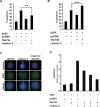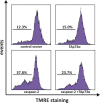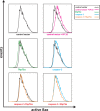TAp73alpha protects small cell lung carcinoma cells from caspase-2 induced mitochondrial mediated apoptotic cell death
- PMID: 22201672
- PMCID: PMC3282073
- DOI: 10.18632/oncotarget.391
TAp73alpha protects small cell lung carcinoma cells from caspase-2 induced mitochondrial mediated apoptotic cell death
Abstract
Caspase-2 is ubiquitously expressed and the most evolutionarily conserved mammalian caspase. It can be activated by a range of death stimuli prior to Bax activation and the occurrence of apoptotic mitochondrial dysfunctions. Caspase-2 has also been reported to exert tumour suppressor function in vivo. The full length TAp73alpha isoform is found up-regulated in various tumour types, and is reported in a cell-type specific manner to repress drug-induced apoptosis. Here, we report that TAp73alpha represses caspase-2 enzymatic activity and by this means reduce caspase-2 induced Bax activation, loss of mitochondrial transmembrane potential and resulting apoptosis. The inhibitory effect on caspase-2 requires the presence of the DNA binding domain and SAM domain region of TAp73alpha. In conclusion, the ability of TAp73alpha to act as an inhibitor of caspase-2-induced cell death together with its up-regulation in certain tumour types strengthen the potential oncogenic activities for this protein.
Conflict of interest statement
The authors confirm that there are no conflicts of interest.
Figures





Similar articles
-
Hsp72 mediates TAp73α anti-apoptotic effects in small cell lung carcinoma cells.J Cell Mol Med. 2011 Aug;15(8):1757-68. doi: 10.1111/j.1582-4934.2010.01166.x. J Cell Mol Med. 2011. PMID: 20807285 Free PMC article.
-
Camptothecin induces p53-dependent and -independent apoptogenic signaling in melanoma cells.Apoptosis. 2011 Nov;16(11):1165-76. doi: 10.1007/s10495-011-0635-8. Apoptosis. 2011. PMID: 21809047
-
c-Myc and caspase-2 are involved in activating Bax during cytotoxic drug-induced apoptosis.J Biol Chem. 2008 May 23;283(21):14490-6. doi: 10.1074/jbc.M801107200. Epub 2008 Mar 28. J Biol Chem. 2008. PMID: 18375382 Free PMC article.
-
Caspase-2 as a tumour suppressor.Cell Death Differ. 2013 Sep;20(9):1133-9. doi: 10.1038/cdd.2013.87. Epub 2013 Jun 28. Cell Death Differ. 2013. PMID: 23811850 Free PMC article. Review.
-
[Caspase-2 as an Oncosupressor and Metabolism Regulator: What Life Will Bring over the Long Run?].Mol Biol (Mosk). 2018 Sep-Oct;52(5):750-763. doi: 10.1134/S0026898418050063. Mol Biol (Mosk). 2018. PMID: 30363050 Review. Russian.
Cited by
-
Recent progress in genetics of aging, senescence and longevity: focusing on cancer-related genes.Oncotarget. 2012 Dec;3(12):1522-32. doi: 10.18632/oncotarget.889. Oncotarget. 2012. PMID: 23455653 Free PMC article. Review.
-
Inhibition of DNA‑PK activity sensitizes A549 cells to X‑ray irradiation by inducing the ATM‑dependent DNA damage response.Mol Med Rep. 2018 Jun;17(6):7545-7552. doi: 10.3892/mmr.2018.8828. Epub 2018 Mar 29. Mol Med Rep. 2018. PMID: 29620203 Free PMC article.
-
TAp73β-mediated suppression of cell migration requires p57Kip2 control of actin cytoskeleton dynamics.Oncotarget. 2013 Feb;4(2):289-97. doi: 10.18632/oncotarget.833. Oncotarget. 2013. PMID: 23470527 Free PMC article.
-
p63 the guardian of human reproduction.Cell Cycle. 2012 Dec 15;11(24):4545-51. doi: 10.4161/cc.22819. Epub 2012 Nov 19. Cell Cycle. 2012. PMID: 23165243 Free PMC article. Review.
-
Recent progress in mapping the emerging landscape of the small-cell lung cancer genome.Exp Mol Med. 2019 Dec 12;51(12):1-13. doi: 10.1038/s12276-019-0349-5. Exp Mol Med. 2019. PMID: 31827074 Free PMC article. Review.
References
-
- Tomasini R, Seux M, Nowak J, Bontemps C, Carrier A, Dagorn JC, Pébusque MJ, Iovanna JL, Dusetti NJ. TP53INP1 is a novel p73 target gene that induces cell cycle arrest and cell death by modulating p73 transcriptional activity. Oncogene. 2005;24:8093–8104. - PubMed
-
- Dobbelstein M, Strano S, Roth J, Blandino G. p73-induced apoptosis: a question of compartments and cooperation. Biochem Biophys Res Commun. 2005;331:688–693. - PubMed
-
- Marqués-García F, Ferrandiz N, Fernández-Alonso R, González-Cano L, Herreros-Villanueva M, Rosa-Garrido M, Fernández-García B, Vaque JP, Marqués MM, Alonso ME, Segovia JC, León J, Marín MC, et al. p73 plays a role in erythroid differentiation through GATA1 induction. J Biol Chem. 2009;284:21139–21156. - PMC - PubMed
-
- Yang A, Kaghad M, Caput D, McKeon F. On the shoulders of giants: p63, p73 and the rise of p53. Trends Genet. 2002;18:90–95. - PubMed
Publication types
MeSH terms
Substances
LinkOut - more resources
Full Text Sources
Other Literature Sources
Medical
Research Materials

